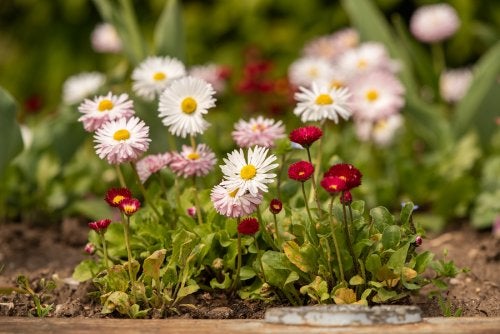Did you know that there are a wide variety of species of daisies? If you want to have them in your garden you should know which are the most popular and how to take care of them. We tell you in detail.

If you are thinking of planting daisies on your balcony or garden, you cannot miss this article. We tell you what the different types of daisies are and how you should take care of each one of them so that your flowers have a long and healthy life. Continue reading!
Daisies and their care.
The daisy is one of the most popular and famous flowers in the world. In many series and movies we have seen the protagonist on duty defoliate a daisy repeating the classic “she loves me, she doesn’t love me.” Now, do you know that there are different species?
As you read, there are more than 140 different species of daisies. The best known flower has a yellow center surrounded by many elongated white petals. However, you can also find it in different colors such as yellow, pink and orange, among others.
Types of daisies and their care.
1. Shasta Daisy.
It is usually large in size and has delicate petals. Its origin is located in the Pyrenees, thus being very resistant to cold climates and frost, although it needs full sun to flourish. The time of flowering is between June and September.
Necessary care:
- Use fertile soil with good drainage.
- Keep the soil moist but not waterlogged to allow the flower to develop properly. The roots of the Shasta daisy cannot stand standing water.
- It is recommended to cut flowers every so often to encourage larger blooms.
- In September, when the flowering stage is over, it is advisable to cut the foliage severely back.
2. Echinacea purpurea.
Although they are similar to the Shasta daisy, they stand out for their intense reddish center and their purple petals. This flower is usually easily found in North America and some parts of South America and Africa, where it is possible to see it reach one meter or even two meters in height.
On the other hand, it is worth noting that echinacea is not only famous for its striking exterior but also has medicinal uses. In fact, it is used as a supplement to increase defenses and treat respiratory infections.
Necessary care:
- It requires a soil with good drainage, since excess water damages it.
- It is also important to remove slugs and snails from their surroundings, due to the serious damage they can cause to the plant.
3. Margaret Gerber.
Among the types of daisies we cannot fail to mention the one commonly known as “gerbera”. Did you know that it is really a kind of daisy? If you look closely at it, you will appreciate its resemblance.
Gerber daisies are generally used in bridal bouquets and for all kinds of flower arrangements. Looking at them, it is easy to see why: they are simply beautiful. Of course, these are fragile flowers that require dedication and work.
Necessary care:
- It is advisable to apply a nutrient mulch when planting it. In addition, you should transplant it in the spring to a larger pot, at least once every two years, so that the plant continues its development.
- Like the aforementioned types of daisies, gerberas cannot withstand excess water, although they do require moist, well-drained soil.
4. Magarza.
The magarza is also known as margarita de Canarias, due to its origin. In fact, in the Canary Islands it grows wild although, of course, they are also cultivated due to their great beauty.
Its flowers stand out for their beautiful colors that include white, yellow and pink, as well as for their lines of single or double petals. In any case, all kinds of magarza require specific care to avoid withering.
Beyond its ornamental use, it is possible to find Canarian margarita preparations in herbalists as a stomach tonic and even as a possible remedy against asthma.
Necessary care:
- It needs direct sun to grow and flourish.
- If using pots, it is better to opt for large sizes (over 40 centimeters).
- Although it resists cold (and even frost) well, it does best at temperatures above 20 °C.
- Irrigation should be moderate, without flooding, and the soil well-drained.
5. Rudbeckia.
Among the types of daisies, rudbeckia is one of the most striking and surely, one of the most difficult to classify at first glance as a margarita.
It is distinguished from the classic one by its bulging burgundy center with small yellow or orange sprinkles at the ends and its wide petals that taper at the tips. Its flowering occurs between June and October.
Necessary care:
- Rudbeckia tolerates semi-shaded places well, but regular sun exposure is recommended.
- Like those already mentioned, it requires well-drained soils and in this case, abundant irrigation is recommended in summer, without leaving standing water in the place.
6. Margarita Thymophylla Tenuiloba.
It is the yellow daisy that we know so well, a beautiful flower with simple care. In fact, it must be one of the best species to get started in the world of daisy gardening.
Necessary care:
- The best location for this plant is in full sun.
- Irrigation should be sufficient to keep the soil moist, without excess.
- If needed, it is possible to use natural fertilizer, always in small doses.
7. Daisy Chrysanthemum furtescens.
Better known as bush daisy, it is a plant that requires more care than many of those mentioned since it grows a little more uncontrolled, thus requiring regular pruning.
Necessary care:
- It is advisable to plant it in full sun.
- Irrigation must be abundant, without flooding.
- It needs periodic fertilization (although not in summer) to develop in a healthy way.
- To prevent the plant from wilting, you should do regular pruning.
8. Daisy Bellis perennis.
This kind of daisy is delicate and its care differs a little from its sisters. It is the variety that we usually find in the meadows, in a natural and wild way.
Necessary care:
- These flowers prefer semi-shade.
- Irrigation must be abundant, especially in hot months. In the fall and winter, watering should be done spaced.
- It is important to take care of the plant from the wind, as it can seriously damage it.
These are just some of the types of daisies that you can find in the market to decorate your home. Go ahead and plant daisies and enjoy these beautiful flowers. Remember to take into account our advice to achieve large and abundant blooms.


